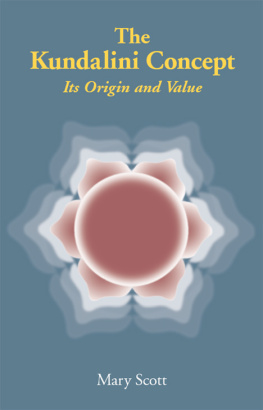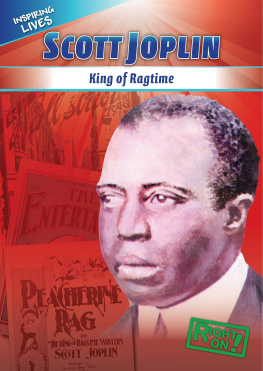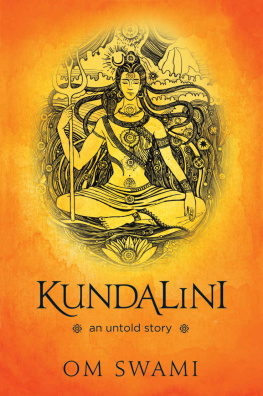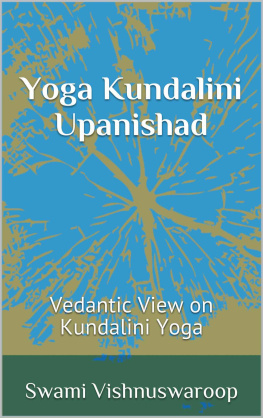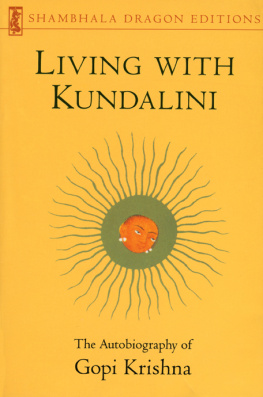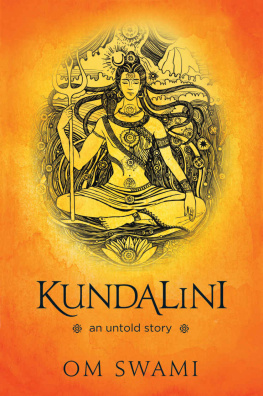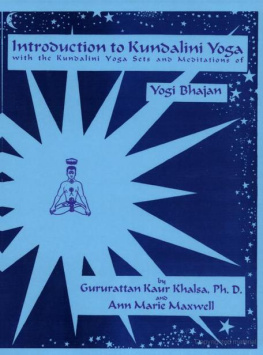Mary Scott - The Kundalini Concept
Here you can read online Mary Scott - The Kundalini Concept full text of the book (entire story) in english for free. Download pdf and epub, get meaning, cover and reviews about this ebook. year: 2006, publisher: Jain Publishing Company, genre: Religion. Description of the work, (preface) as well as reviews are available. Best literature library LitArk.com created for fans of good reading and offers a wide selection of genres:
Romance novel
Science fiction
Adventure
Detective
Science
History
Home and family
Prose
Art
Politics
Computer
Non-fiction
Religion
Business
Children
Humor
Choose a favorite category and find really read worthwhile books. Enjoy immersion in the world of imagination, feel the emotions of the characters or learn something new for yourself, make an fascinating discovery.
- Book:The Kundalini Concept
- Author:
- Publisher:Jain Publishing Company
- Genre:
- Year:2006
- Rating:5 / 5
- Favourites:Add to favourites
- Your mark:
- 100
- 1
- 2
- 3
- 4
- 5
The Kundalini Concept: summary, description and annotation
We offer to read an annotation, description, summary or preface (depends on what the author of the book "The Kundalini Concept" wrote himself). If you haven't found the necessary information about the book — write in the comments, we will try to find it.
The Kundalini Concept — read online for free the complete book (whole text) full work
Below is the text of the book, divided by pages. System saving the place of the last page read, allows you to conveniently read the book "The Kundalini Concept" online for free, without having to search again every time where you left off. Put a bookmark, and you can go to the page where you finished reading at any time.
Font size:
Interval:
Bookmark:

The Kundalini Concept
Its Origin and Value
The Kundalini Concept
Its Origin and Value
by
Mary Scott

JAIN PUBLISHING COMPANY
Fremont, California
_____________
jainpub.com
Jain Publishing Company, Inc. is a diversified publisher of college textbooks and supplements, as well as professional and scholarly references, and books for the general reader. A complete, up-to-date listing of all the books, with cover images, descriptions, review excerpts, specifications and prices is always available on-line at jainpub.com. Our booksPLUS division provides custom publishing and related services in print as well as electronic formats, and our learn24x7 division offers electronic course and training materials development services.
The author and publisher would like to thank the following for permission to reproduce illustrations: Alice Bailey and Lucis Publishing Company (A Treatise on Cosmic Fire) for .
Library of Congress Cataloging-in-Publication Data
Scott, Mary, 1906
The kundalini concept : its origin and value / by Mary Scott.
p. cm.
Rev. ed. of: Kundalini in the physical world. London ; Boston : Routledge & Kegan Paul, 1983.
Includes bibliographical references and index.
ISBN-13: 978-0-89581-857-7 (hardcover : alk. paper)
ISBN-10: 0-89581-857-4 (hardcover : alk. paper)
1. Kualin. 2. Tantrism. I. Scott, Mary, 1906- . Kundalini in the physical world. II. Title.
BL1215.K8S36 2006
294.5'436dc22
2006008437
Copyright 2006 by Mary Scott. All rights reserved. No part of this book may be reproduced, stored in a retrieval system, or transmitted, in any form or by any means, electronic, mechanical, photocopying, recording or otherwise, without the written permission of the publisher except for brief passages quoted in a review.
Contents
Nowadays books on Eastern psycho-spiritual traditions and on the relationships between these traditions and Western science proliferate. Why then should I give such a welcome to the reappearance, albeit in a revised and updated form, of a book that first appeared in the 1980s? The answer is that in spite of the availability of so many books in the field, there is nothing quite like Kundalini in the Physical World now retitled (The Kundalini Concept: Its Origin and Value). It still stands as one of the most remarkable publications of the last several decades, a book bright with wisdom, scholarship, and spiritual understanding. No one who reads it is likely to remain uninspired and unchanged by it.
As inferred in her Preface Mary Scotts book is a work of serious-minded scholarship, based upon a wide knowledge of Eastern spirituality and of relevant areas of Western science. It is unfortunate that when the book first appeared the then publishers regarded it as simply another addition to the Mind Body Spirit shelves of the local bookshop. As such it never received the attention from psychologists, physicists and other scientists that it deserved. My hope is that its reappearance will put matters right. For we have here a book that not only clarifies what is meant by the much misused term kundalini, but that provides new and compelling insights into our scientific understanding of mind and matter, and of the energies that activate them. In addition, its existence as a work of scholarship does not and should not make it inaccessible to the lay reader. Mary Scotts clarity of expression and her concern to help those who may have been affected negatively by misguided attempts to raise kundalini mean that her book can be understood and will appeal to people from all backgrounds.
In effect, the book provides us with a wide-ranging and perceptive enquiry into the very nature of reality. Increasingly many peopleboth researchers and lay men and womenhave become dissatisfied with the reductionist philosophy that has long dominated modern thinking and driven modern science. Such a philosophy seeks to reduce all phenomenamental, spiritual and physicalto a uniform level, that of materiality. Mindthoughts, feelings, emotions, dreams, imaginationis thus seen as no more than the workings of the electro-chemical systems within the brain, and soul and spirit are relegated to the realms of superstition. This philosophy may seem satisfying enough to the scientist when working in the laboratory, but it does not accord with the way in which people experience their own being. However, as Mary Scott makes clear, many of the theoretical models of the scientist and many of the practical experiences of real life need not necessarily be seen as antagonistic to each other. Each can be enriched by the other provided that men and women exist who are well-versed in both fields, and can identify the relevant meeting points between them.
For Mary Scott is intent not upon attacking Western science but upon illuminating it by comparisons with the great Eastern traditions of thought, thereby helping it to achieve new areas of understanding and endeavour. Such illumination is long overdue, at both the scientific and spiritual levels, and the more we are able to see beyond differences in terminology and in emphasis between Eastern and Western traditions, the more we can recognize that many of the same fundamental truths about the nature of reality have been identified by scholars in spite of separation by distance and time. Inevitably some Western scientists will disagree with her descriptions and interpretations of Western science given the challenges represented by the subject, and the many ways in which we can approach and interpret its findings and its conclusions. But for all those who read the book with an open mind and an awareness of our need to show humility before the deep mysteries of science, even such disagreements should prove a welcome stimulus to further thought and constructive debate.
The term kundalini has all sorts of esoteric connotations, but stripped of these it can be thought of simply as energy, as a life-force that not only animates living systems but also pervades the very planet itself. Modern quantum physicists make clear that the world as we see it is not ultimate reality. Everything that exists, from the highest mountains to our own bodies, is a flux of subatomic energy, a flux that gives apparent solidity to the visible world only by virtue of the fact that it is in rapid motion. The table on which I write these words appears inert and impenetrable to my senses, but is in fact composed almost entirely of empty space, and even the flux of energythe one aspect of it that is not emptyturns out itself to be no more solid than this empty space. Thus kundalini must not be thought of solely in the highly symbolic images of the yogis that is as a form of serpent power residing at the base of the spine. Instead it must be thought of as composing the very stuff of which we, and the world are made, a stuff which as explained by Mary Scott corresponds closely at a number of points with the energy flux spoken of by the quantum physicist.
Up to now I have referred only to the theoretical ideas that underlie this splendid book, but this is not to suggest that the book is composed only of theory. It serves also as an illuminating practical manual, a manual which not only teaches us much about what we might do with the energies of which we are composed and how we might do it, but which elucidates that mysterious set of teachings known in the East as the tantras. Many people thank of the tantras as a collection of writings about sexuality and sexual indulgence. They could hardly be more wrong. The tantras reveal an extraordinary understanding of how to channel the energy systems which make up our being. In the tantras we possess one of the most advanced set of teachings about physical, psychological and spiritual development in world literature, and we can but marvel at the wisdom of the ancients who put together these remarkable texts. Few books exist that elucidate the tantras, and fewer still that are written byand accessible toWesterners. This is one of them.
Font size:
Interval:
Bookmark:
Similar books «The Kundalini Concept»
Look at similar books to The Kundalini Concept. We have selected literature similar in name and meaning in the hope of providing readers with more options to find new, interesting, not yet read works.
Discussion, reviews of the book The Kundalini Concept and just readers' own opinions. Leave your comments, write what you think about the work, its meaning or the main characters. Specify what exactly you liked and what you didn't like, and why you think so.

